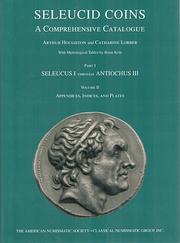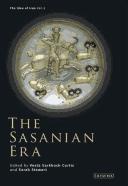| Listing 1 - 10 of 15 | << page >> |
Sort by
|
Book
ISBN: 9782356130037 2356130039 Year: 2008 Volume: 3 Publisher: Bordeaux: Ausonius,
Abstract | Keywords | Export | Availability | Bookmark
 Loading...
Loading...Choose an application
- Reference Manager
- EndNote
- RefWorks (Direct export to RefWorks)
Coins, Greek --- Coins, Ancient --- Monnaies grecques --- Monnaies antiques --- Catalogs. --- Catalogues
Book
ISBN: 9789077297452 9077297456 Year: 2008 Volume: 77 Publisher: Wetteren Moneta
Abstract | Keywords | Export | Availability | Bookmark
 Loading...
Loading...Choose an application
- Reference Manager
- EndNote
- RefWorks (Direct export to RefWorks)
Coins, Carolingian --- Coins, Medieval --- Monnaies carolingiennes --- Monnaies médiévales --- Catalogs --- Catalogues --- Monnaies médiévales --- Coins (Carolingian )

ISBN: 9780980238723 9780980238709 9780980238716 0970926839 0970926847 0970826855 0980238722 0980238706 0980238714 9780970926845 9780970926838 Year: 2008 Volume: 7 Publisher: new York: American numismatic society,
Abstract | Keywords | Export | Availability | Bookmark
 Loading...
Loading...Choose an application
- Reference Manager
- EndNote
- RefWorks (Direct export to RefWorks)
Coins, Greek --- Monnaies grecques --- Monnaies séleucides --- Séleucides (dynastie) --- Monnaies séleucides. --- Séleucides --- Coins, Greek - Catalogs
Book
ISBN: 9782970007128 2970007126 Year: 2008 Publisher: Genève ; Bruxelles Tradart Institut
Abstract | Keywords | Export | Availability | Bookmark
 Loading...
Loading...Choose an application
- Reference Manager
- EndNote
- RefWorks (Direct export to RefWorks)
Coins, Ancient --- Coins, Greek --- Coins, Roman --- Monnaies antiques --- Monnaies grecques --- Monnaies romaines --- Private collections --- Collections privées --- Collections privées
Book
ISBN: 9781843833710 Year: 2008 Volume: 1 Publisher: Woodbridge ; Rochester The Boydell Press
Abstract | Keywords | Export | Availability | Bookmark
 Loading...
Loading...Choose an application
- Reference Manager
- EndNote
- RefWorks (Direct export to RefWorks)
Coins, Anglo-Saxon --- Coins, Medieval --- Monnaies anglo-saxonnes --- Monnaies médiévales --- Congresses --- Congrès --- Monnaies médiévales --- Congrès --- Anglo-Saxon coins --- Congresses. --- Coins, Anglo-Saxon.

ISBN: 9781845116903 1845116909 Year: 2008 Volume: 3 Publisher: London ; New York I.B. Tauris
Abstract | Keywords | Export | Availability | Bookmark
 Loading...
Loading...Choose an application
- Reference Manager
- EndNote
- RefWorks (Direct export to RefWorks)
This latest volume in "The Idea of Iran" series concentrates on the Sasanian period. Seizing power from the previous dynasty - the Parthians - the Sasanians ruled Iran and most of the ancient Near East from 224 until 642 CE. They are particularly fascinating because of their adherence to Zoroastrianism, an ancient dualistic Iranian religion named after the prophet Zarathustra (or, in Greek, Zoroaster). The Sasanians expressed the divine aspect of their rule in a variety of forms, such as on coins, rock reliefs and silver plates, and architecture and the arts flourished under their aegis. Sasanian military success brought them into conflict with Rome, and later Byzantium. Their empire eventually collapsed under the force of the Arab army in AD 642, when Zoroastrianism was replaced with Islam.Engaging with all the major aspects of Sasanian culture, twelve eminent scholars address subjects which include: early Sasanian art and iconography; early Sasanian coinage; religion and identity in the Sasanian empire; later Sasanian orality and literacy; and state and society in late antique Iran.The volume in question arguably comprises the most complete and comprehensive treatment of the Sasanian civilization yet to be published in English.
Sassanids --- Sassanides --- Iran --- History --- Histoire --- Sassanides (dynastie) --- Monnaies sassanides
Dissertation
Abstract | Keywords | Export | Availability | Bookmark
 Loading...
Loading...Choose an application
- Reference Manager
- EndNote
- RefWorks (Direct export to RefWorks)
monnaie --- monnaies médiévales --- liège (principauté) --- 972-1274
Book

ISBN: 9789607905482 9607905482 Year: 2008 Volume: 62 Publisher: Athens: Research Centre for Greek and Roman Antiquity, National Hellenic Research Foundation,
Abstract | Keywords | Export | Availability | Bookmark
 Loading...
Loading...Choose an application
- Reference Manager
- EndNote
- RefWorks (Direct export to RefWorks)
Coins, Greek --- Coins, Ancient --- Monnaies grecques --- Monnaies antiques --- Maroneia (Extinct city) --- Thrace --- Maronia (Ville ancienne) --- Antiquities. --- Antiquités --- Antiquities --- Antiquités --- Coins, Greek - Greece - Maroneia (Extinct city) --- Coins, Ancient - Thrace --- Maroneia (Extinct city) - Antiquities --- Thrace - Antiquities
Book
ISBN: 9782877723701 2877723704 Year: 2008 Publisher: Paris Éditions Errance
Abstract | Keywords | Export | Availability | Bookmark
 Loading...
Loading...Choose an application
- Reference Manager
- EndNote
- RefWorks (Direct export to RefWorks)
Numismatics --- Numismatics, Ancient --- Coins, Ancient --- Medals, Ancient --- Numismatique --- Numismatique antique --- Monnaies antiques --- Médailles antiques --- History --- Histoire --- History. --- Médailles antiques --- Médailles
Book
ISBN: 9782701146577 2701146577 Year: 2008 Publisher: Paris : Belin,
Abstract | Keywords | Export | Availability | Bookmark
 Loading...
Loading...Choose an application
- Reference Manager
- EndNote
- RefWorks (Direct export to RefWorks)
"Les historiens ont longtemps affirmé qu'il n'était pas possible d'appliquer au monde antique une analyse centrée autour de la notion de marché. Réservée aux époques ultérieures, celle-ci serait anachronique. Depuis une trentaine d'années, de nombreux travaux ont montré qu'il n'en était rien. L'économie des cités grecques ne méconnaît pas le marché comme institution économique. Dans cette perspective, en raison de l'abondance des sources et de leur diversité, Athènes à l'époque classique apparaît comme un terrain d'étude privilégié pour décrire la naissance et le fonctionnement d'une économie de marché.L'étape initiale de cette histoire est constituée par les premières frappes monétaires athéniennes. C'est à partir de la monnaie que les Athéniens parviennent ensuite à construire un marché à l'échelle du monde égéen, garantissant l'approvisionnement de la cité et, plus généralement, l'abondance. Cette construction résulte de décisions prises par l'assemblée des citoyens qui s'inscrivent toujours dans le cadre marchand de l'économie.Dans l'Athènes classique, le marché se trouve au cœur même du politique. La cité athénienne est donc aussi une démocratie de marché."--
Money --- Monetary policy --- Monnaie --- Politique monétaire --- History --- Histoire --- Athens (Greece) --- Greece --- Athènes (Grèce) --- Grèce --- Economic conditions --- History. --- Conditions économiques --- Économie de marché --- Monnaies grecques --- Conditions économiques
| Listing 1 - 10 of 15 | << page >> |
Sort by
|

 Search
Search Feedback
Feedback About UniCat
About UniCat  Help
Help News
News